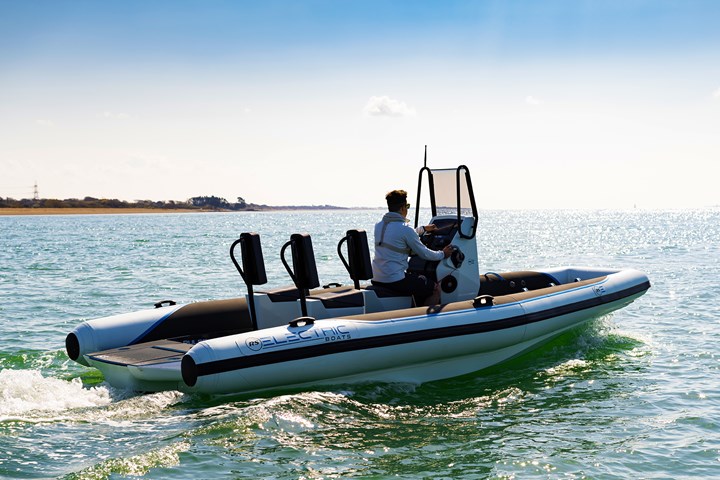
First-run all-electric boat with recycled materials. The Pulse 63 is the first all-electric rigid inflatable boat (RIB) produced by RS Sailing sister brand RS Electric Boats, incorporating fiberglass and recycled carbon fiber in most major structural components. The first customer boats are set to hit the water in early 2022. Photo Credit: RS Sailing
RS Sailing (Romsey, U.K.) is known for producing world-class sailing boats, and claims to use as many recyclable materials as possible in their production. Three years ago, the company formed sister brand RS Electric Boats, which specializes in the design and manufacture of battery-electric, rigid inflatable boats (RIB) — lightweight motorboats with a rigid hull and inflated, high-pressure air tubes on the boat’s sides for extra buoyancy. RIBs are used recreationally and are often employed by first responders, military operators or coaching staff for boat racing.
Alex Newton-Southon, CEO – design & technologies at RS Sailing, explains that as carmakers look to become more electrified and are thinking about sustainable manufacturing and materials, RS Electric Boats wants to do the same in the marine market. “It’s obvious to us that electric boats are the way the market is going to go. In reality, a conventional outboard motor is about 50 times more polluting than today’s cars. We want to do our bit to help protect the planet,” he says.
Pushing the market toward more sustainable propulsion, materials and manufacturing choices has been a goal for the past three years, as RS Electric Boats has been working to develop and commercialize its first battery-electric RIB. In 2019, RS Electric Boats debuted the Pulse 58 concept RIB at the Düsseldorf International Boat Show in Germany. This demonstrator boat featured several flax fiber/bio-epoxy components, including the hull, deck and consoles.
Since then, materials decisions and the overall design have been iterated at least three times — “plus a significant amount of tweaking across the whole boat,” Newton-Southon concedes — ultimately resulting in the Pulse 63, set to hit the market in early 2022.
The first, flax fiber composite iteration: Pulse 58
Most RIBs are driven by standard fuel-powered engines, with some exceptions for small (one- to two-person) battery-powered designs. RS Electric Boats claims the Pulse 63, designed to carry up to eight people, is the first in the industry to use all-electric propulsion for a boat of its size.
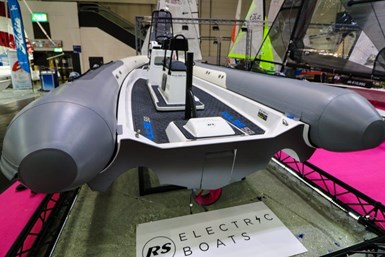
First iteration: Flax fiber. The original Pulse 58 design (pictured here) incorporated a flax fiber composite hull that proved too difficult to source for commercial production. Still, RS Electric Boats took a lot of the original design and sustainability goals and transferred them to the next-generation Pulse 63. Photo Credit: Norco
The boat’s hull and overall shape had to be designed specifically to accommodate electric propulsion. “One thing that’s very apparent when you start designing a battery-electric RIB is that you can’t just add an electric drive system onto a normal boat. You have to start from scratch, because the design has to allow the boat to be super efficient, and some of that is down to weight. It’s very important that the boat is constructed as strong and as stiff as you can, just to make it as light as you can,” Newton-Southon explains.
The battery console is “the main structure for the whole thing,” he adds. The boat hull is a solid monolithic structure, with a connected deck that also houses the batteries. No transverse bulkhead or frames are needed.
The 5.8-meter Pulse 58 RIB that RS Electric Boats launched in 2019 featured a hull, deck, console, battery box and seat moldings manufactured via infusion by local fabricator Norco (Poole, U.K.) from bio-based epoxy, naturally sourced flax fiber and recycled PET core where needed.
In 2019 and 2020, RS Electric Boats aimed to ramp up production for the Pulse 58 and start selling to customers. However, setbacks caused by the COVID-19 pandemic, as well as sourcing issues for the bio-based materials, led to a brief delay and some design shifts.
Design iterations and recycled carbon fiber: Pulse 63
In May 2021, RS Electric Boats decided to refresh the brand, aligning with design changes and material decisions made in preparation for ramping up production. The composite components for the renamed 6.3-meter Pulse 63 are manufactured by MTAG Composites Ltd. (Coningsby, U.K.), a fabricator that has worked with RS Sailing on tooling development and boat manufacture for many years. As marketed, the Pulse 63 RIB can reach a top speed of 23 knots and has a maximum range of 100 nautical miles. It can also be customized with a variety of optional features such as tow posts, single-point lifts, canopies and various seating configurations.
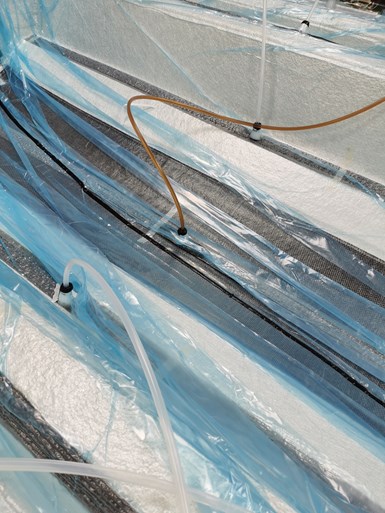
Infusing dry recycled carbon fiber. Recycled carbon fiber sourced from MTAG Composites’ aerospace projects is used for several infused structural components on the Pulse 63. RS Sailing hopes to incorporate more recycled materials in future.
Photo Credit: MTAG Composites
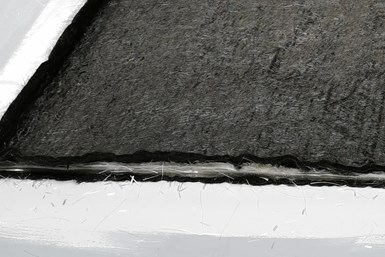
The boat’s composite components include the hull, deck, interior floor, consoles, engine box and hatches. However, sourcing the flax fiber and bio-based epoxy used in the original design proved more difficult than expected at the levels needed for serial production of the boats.
“Material decisions will change over the next few years for sure, as natural fibers and bio-based resins become more attainable,” Newton-Southon says. Currently, the boat’s monolithic hull combines glass and carbon fiber fabrics infused with vinyl ester. To reduce weight, the hull is not cored, but reinforced instead with layers of carbon fiber. All other composite components of the boat — interior deck, floor, consoles, engine box and hatches — are built from recycled carbon fiber and vinyl ester, with recycled PET core (supplied by 3A Composites Core Materials, Sins, Switzerland) as needed. “The hull isn’t made from recycled materials at this time, just to give us some more time for development and testing on that,” he notes.
With the resin, RS Electric Boats opted for a more traditional vinyl ester over bio-based epoxy for several reasons. One was availability. According to Newton-Southon, the drive for producing truly sustainable resins — in commercial quantities — has been slower than he would like. “It’s not just the prices,” he says, “it’s about being able to believe in products for the long term. What will happen to these products in 10 years’ time? Will the material hold up? They’re so new that we don’t really know yet. There’s a demand out there, and we’re willing to spend a little bit more for more sustainable materials, but we need to able to trust in the life of the product.”
The bio-based epoxy also proved difficult to use with resin infusion. “When you use any sort of epoxy in an infusion process, you can’t use reusable silicone vacuum bags,” Newton-Southon explains. The epoxy reacts with the silicone, and silicone bags designed to last for 100-150 cycles might only last for five. “You end up with a huge amount of landfill waste from the manufacturing process,” he says. Vinyl ester was chosen as the best option for use with silicone bags.
He adds, “For now, if you do a lifecycle analysis on the materials, we feel that reducing the infusion waste to landfill is far greater of a step in the right direction than trying to use a slightly more sustainable resin. The process is as sustainable with as little waste as we can make it.”
Tim King, technical sales and marketing manager and project manager at MTAG Composites, notes, “Bio-based vinyl esters are coming down the line, but they’re just not commercially viable for products of this size yet. They’re only made in relatively small quantities.”
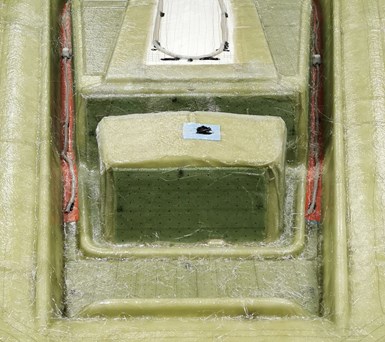
Recycled PET core. In areas of the boat’s structure needing additional reinforcement, recycled PET core from 3A is used. Photo Credit: MTAG Composites
For the fiber, the recycled carbon fiber for the boats is reused scrap from MTAG Composites’ work on carbon fiber aircraft seats. “It’s direct return to use, processed through third party manufacturer Gen 2 Carbon [formerly ELG Carbon Fibre, Coseley, U.K.],” King says.
Rather than chop up the fibers or process them into a prepreg, MTAG infuses a dry recycled carbon fiber nonwoven directly. “This is particularly difficult to do, given the density of the recycled fibers. It doesn’t like to fill in with resin, but we figured out a process to do it successfully,” King says.
The process was first demonstrated in 2019 on the RS Neo foredeck, where MTAG Composites and RS Sailing replaced traditional fiberglass reinforcement with recycled carbon fiber. “This has been coming for a number of years, but I know we at MTAG, and Gen 2, are glad to see this product and process go forward,” King says.
Concerning the aesthetic appearance of the recycled fiber, he adds, “You can cover it up with a gelcoat of course, but for me personally, I quite like the visuals of the recycled product. It’s nice to see that identifiable source material being reused.”
In the end, “about 60% of the boat’s composite components are made from recycled materials, either PET core or carbon fiber scrap,” King says. All of the composite parts are infused under vacuum, except for a few small fitments that will be hand-laid with dry materials.
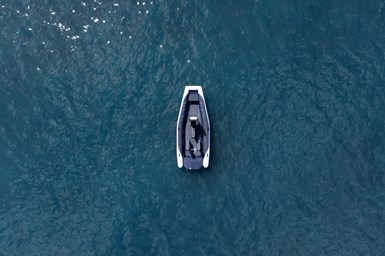
Setting sail in 2022. About 60% of the components on the Pulse 63 are made from recycled materials, according to fabricator MTAG. Photo Credit: RS Sailing
The tooling for the Pulse 58 served as the basis for the new Pulse 63 tools, which MTAG Composites altered per RS Electric’s specifications. All of the tools — 22 total, consisting of four solid infusion tools, six tools for hand layup and 12 silicone bagged tools — are composite, and made in-house by Norco or MTAG. To account for design changes on the hull, some of the tools needed to be re-machined, and for some, special inserts were made to add shape back to the mold.
“We have a very active mold shop in-house, and some very skilled guys who were able to take the original prototype tooling and in some cases apply some quite drastic changes to it,” King explains. The team started on the tools in February 2021, and the final tools were delivered in August.
The first four Pulse 63 boats are slated for production by the end of the year, ready to be displayed at the Düsseldorf International Boat Show in January 2022. Going forward, Newton-Southon adds that composite materials used for the Pulse 63 and future RS Electric Boats models will likely change as new materials become available, and with market demand. “We’re taking it one step at a time, but I think one thing we’ve become pretty good at is helping the supply chain understand what kinds of products the market needs.”
Related Content
Manufacturing the MFFD thermoplastic composite fuselage
Demonstrator’s upper, lower shells and assembly prove materials and new processes for lighter, cheaper and more sustainable high-rate future aircraft.
Read MoreTU Munich develops cuboidal conformable tanks using carbon fiber composites for increased hydrogen storage
Flat tank enabling standard platform for BEV and FCEV uses thermoplastic and thermoset composites, overwrapped skeleton design in pursuit of 25% more H2 storage.
Read MoreCarbon fiber, bionic design achieve peak performance in race-ready production vehicle
Porsche worked with Action Composites to design and manufacture an innovative carbon fiber safety cage option to lightweight one of its series race vehicles, built in a one-shot compression molding process.
Read MorePlant tour: Albany Engineered Composites, Rochester, N.H., U.S.
Efficient, high-quality, well-controlled composites manufacturing at volume is the mantra for this 3D weaving specialist.
Read MoreRead Next
Developing bonded composite repair for ships, offshore units
Bureau Veritas and industry partners issue guidelines and pave the way for certification via StrengthBond Offshore project.
Read More“Structured air” TPS safeguards composite structures
Powered by an 85% air/15% pure polyimide aerogel, Blueshift’s novel material system protects structures during transient thermal events from -200°C to beyond 2400°C for rockets, battery boxes and more.
Read MorePlant tour: Daher Shap’in TechCenter and composites production plant, Saint-Aignan-de-Grandlieu, France
Co-located R&D and production advance OOA thermosets, thermoplastics, welding, recycling and digital technologies for faster processing and certification of lighter, more sustainable composites.
Read More

.jpg;width=70;height=70;mode=crop)






.jpg)














